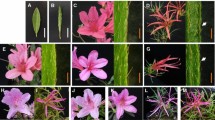Abstract
Most current cultivars of narrow-leafed lupin have an indeterminate growth habit such that vegetative growth continues while the pods are being filled, causing strong intra-plant competition for assimilates. Restricted-branching (RB) genotypes can reduce this tendency and raise the proportion of the plant's biomass going into grain. Studies on the inheritance of the RB trait showed that two spontaneous mutants, P25598 and P21227, each carried a single incompletely dominant allele conferring the trait, whereas two other spontaneous mutants, P24743 and P25582, and two induced mutants, P26021 and P21238, each carried a single recessive allele conferring the trait. The RB alleles present in P26021 and P21238 seem to be the same, and to be at the same locus as (or tightly linked to) the allele controlling the RB trait in P21227. Similarly, the genes present in P21227 and the induced mutant P25735 appear to be the same when these lines are crossed. However, they do not behave the same in crosses with P26021: thus we propose that there are at least three alleles at the same locus (or at tightly linked loci) that confer RB. Normal-branching plants that are heterozygous at an RB locus generally have fewer leaves on the uppermost branch than homozygous-normal plants. Similarly, RB plants that are heterozygous generally have fewer branchless nodes on the main stem than homozygous-RB plants. The RB trait is associated with a small but significant reduction in the number of leaves on the main stem. However, this relationship is weak and will not prevent plant breeders from selecting both early- and late-flowering RB genotypes.
Similar content being viewed by others
References
ABARE, 1999. Australian Grain Industry: Performance by GRDC agroecological zones. pp. 3 Australian Bureau of Agricultural and Resources Economics, Canberra.
Bromberek, S., J. Mikolajczyk & M. Wiza, 1984. Self-ending mutation in blue lupin. In: Proceedings of the 3rd International Lupin Conference, pp. 566–567, La Rochelle, France.
Debelyi, G.A. & V.I. Derbenskii, 1988. Determinant forms of blue lupine (Lupinus angustifolius): Salient features. In: Proceedings of the 5th International Lupin Conference, pp. 494–498, Poznan, Poland.
Donald, C.M. & J. Hamblin, 1983. The convergent evolution of annual seed crops in agriculture. Advances in Agronomy 36: 97–143.
Dracup, M., 1994. Physiological aspects to lupin improvement for water-limited Mediterranean environments. In: M. Dracup and J. Palta (Eds.), Proceedings of the First Australian Lupin Symposium. pp. 140–151. Western Australian Department of Agriculture, Perth.
Dracup, M. & E.J.M. Kirby, 1993. Patterns of growth and development of leaves and internodes of narrow-leafed lupin. Field Crops Research 34: 209–225.
Dracup, M. & J.M. Kirby, 1996a. Lupin Development Guide, pp. 97. University of Western Australia Press, Perth.
Dracup, M. & E.J.M. Kirby, 1996b. Pod and seed growth and development of narrow-leafed lupin in a water limited Mediterraneantype environment. Field Crops Research 48: 209–222.
Dracup, M., W. Cowling & R.J. Thomson, 1998a. Growing Tallerack narrow leafed lupin. Farmnote No. 26/98. Agriculture Western Australia.
Dracup, M., M. Reader & J. Palta, 1998b. Variation in yield of narrow-leafed lupin caused by terminal drought. Aust J Agric Res 49: 799–810.
Dracup, M., R.J. Thomson, M. Reader, E.J.M. Kirby, I. Shield & J. Leach, 1998c. Daylength responses, flowering time and seed filling in lupin. Aust J Agric Res 49: 1047–1055.
Dracup, M. & R.J. Thomson, 2000. Narrow-leafed lupins with restricted branching. Annals of Botany 85: 29–35.
Faris, J.D., B. Laddomada & B.S. Gill. 1998. Molecular mapping of segregation distortion loci in Aegilops tauschii. Genetics 149: 319–327.
Free, J.B, 1970. Insect pollination of crops. Academic Press, London.
Gladstones, J.S., 1994. An historical review of lupins in Australia. In: M. Dracup and J. Palta (Eds.), Proceedings of First Australian Lupin Technical Symposium, pp. 1–39. Department of Agriculture, Western Australia.
Genstat 5 Committee, 1993. Genstat 5 Release 3 Reference Manual. Clarendon Press, Oxford, England.
Hamblin, J., R. Delane, A. Bishop & J. Gladstones, 1986. Yield potential of reduced branching lupins (Lupinus angustifolius) on sandy soils in a short-season environment. Aust J Agric Res 37: 611–620.
Loegering, W.Q. & E.R. Sears, 1963. Distorted inheritance of stem rust resistance of Timstein wheat caused by a pollen-killing gene. Can J Genet Cytol 5: 65–72.
Perry, M.W. & M.L. Poole, 1975. Field environment studies in lupins. I. Developmental patterns in Lupinus angustifolius L., the effect of cultivar, site and planting time. Aust J Agric Res 26: 81–91.
Perry, M.W., R.J. Delane, D. Tennant & A.P. Hamblin, 1986. The growth and grain yield of lupins in relation to the soil water balance. In: Proceedings of the 4th International Lupin Conference, Geraldton, pp. 112–128. Western Australian Department of Agriculture.
Seymour, M., 1996. Response of narrow-leafed lupin (Lupinus angustifolius L.) to foliar application of growth regulators in Western Australia. Australian Journal of Experimental Agriculture 36: 473–478.
Swiecicki, W. & W.K. Swiecicki, 1995. Domestication and breeding improvement of narrow-leafed lupin (Lupinus angustifolius L.). J Appl Genet 36: 155–167.
Author information
Authors and Affiliations
Rights and permissions
About this article
Cite this article
Adhikari, K., Galwey, N. & Dracup, M. The genetic control of highly restricted branching in narrow-leafed lupin (Lupinus angustifolius L.). Euphytica 117, 261–274 (2001). https://doi.org/10.1023/A:1026571416075
Issue Date:
DOI: https://doi.org/10.1023/A:1026571416075




